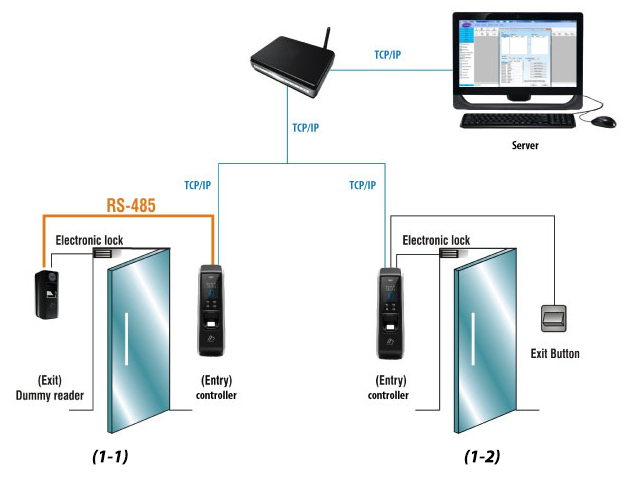Access control system maintenance service
Access control system maintenance service is essential to ensure security, system reliability, and proper functioning. An effective access control system maintenance service includes a range of tasks such as regular inspections, software updates, hardware checks, and troubleshooting. These services help prevent system failures, unauthorized access, and costly repairs. Here’s what a typical access control maintenance service entails:
1. System Health Check and Inspection
- Regular Site Inspections: Routine visits to check the overall health of the system, ensuring that all components (keypads, card readers, biometric scanners, electric locks, etc.) are functioning properly.
- Visual Inspection: Ensure that all entry points (doors, gates) and system components are undamaged, free of obstruction, and secure.
- Test System Components: Verify that access readers (card, fingerprint, or facial recognition scanners) respond accurately and quickly. Ensure that magnetic or electric door locks open and close as expected.
- Check Backup Power Systems: Ensure the uninterruptible power supply (UPS) or battery backups are functioning to maintain access control during power outages.
2. Software Updates and Security Patches
- Firmware and Software Updates: Regularly updating the system’s firmware and software to enhance performance, fix bugs, and address security vulnerabilities.
- Security Patches: Ensure that any security patches from the manufacturer are applied to prevent potential cybersecurity risks.
- Audit Logs Review: Check access logs for any anomalies or irregular access patterns, and ensure data integrity for auditing and compliance.
3. Testing Authentication Methods
- Card and Key Fob Readers: Ensure that card and key fob readers work without delays and recognize valid credentials while rejecting unauthorized access.
- Biometric Scanners: Test fingerprint or facial recognition systems to ensure accuracy, speed, and proper enrollment of users.
- PIN Keypads: Test all PIN-based access points to verify they function properly without lag or errors in PIN recognition.
4. Door and Lock Maintenance
- Door Closers and Hinges: Check that door closers, hinges, and other mechanical parts are functioning properly, as they are essential for smooth door operations.
- Locks and Magnetic Strikes: Test electronic locks, magnetic strikes, and other access control hardware to ensure that doors lock and unlock correctly.
- Exit Buttons and Emergency Exits: Check all exit buttons, release mechanisms, and ensure emergency exits operate correctly.
5. Integration Check
- System Integrations: If the access control system is integrated with other security systems like video surveillance, alarm systems, or building automation, ensure that these systems are working together seamlessly.
- Database and Network Connectivity: Ensure that the access control system is properly communicating with servers, databases, and networks, avoiding data loss or access issues.
6. User Management and Credential Updates
- Add/Remove Users: Review and update user credentials in the system, removing access for individuals no longer authorized and adding new employees or users.
- Credential Expiration: Review and renew expired or soon-to-expire credentials (e.g., access cards, key fobs) and ensure users have uninterrupted access.
- Role-Based Access Review: Check that access permissions are properly assigned and up to date according to user roles and security policies.
7. System Performance Monitoring
- Monitoring Logs: Review logs to monitor access control events, identify potential unauthorized attempts, and ensure all components are actively logging access events.
- Analytics and Reporting: Some modern systems have analytics capabilities that detect abnormal access patterns (e.g., too many failed login attempts) and generate detailed reports.
8. Troubleshooting and Repair
- Component Repairs: Identify and repair or replace faulty hardware components (readers, locks, power supplies).
- System Reboots and Resets: Perform controlled reboots or resets of the access control system to resolve software or connectivity issues.
- Cable and Connectivity Checks: Ensure that all cables and network connections (wired or wireless) are intact and functioning.
9. Emergency Maintenance Services
- 24/7 Support: Many access control maintenance providers offer emergency repair services to address urgent issues like system lockouts, security breaches, or system malfunctions.
- Remote Support: In some cases, providers can access systems remotely to diagnose and fix software-related issues quickly.
10. Training and Support
- User Training: Provide updated training to security personnel and system users on how to operate the access control system, including troubleshooting common issues.
- Documentation: Maintain up-to-date records of system configurations, access policies, and maintenance schedules.
11. Compliance and Certification
- Audit Readiness: Ensure the access control system complies with industry standards and certifications (e.g., PCI-DSS, GDPR, etc.) as needed for the business.
- Access Logs: Ensure logs and reporting tools are in place to generate access reports for audits and compliance purposes.
Maintenance Frequency Recommendations:
- Monthly: Basic inspections like checking card readers, software updates, and access logs review.
- Quarterly: Comprehensive system checks including door mechanisms, locks, and integrations.
- Annually: Full system audits, firmware upgrades, and battery replacement for backup power systems.
Benefits of Regular Access Control System Maintenance:
- Increased Security: Regular checks ensure that all entry points are secure and functioning, reducing the risk of unauthorized access.
- Reduced Downtime: Preventive maintenance helps avoid unexpected failures that could lead to downtime or costly repairs.
- Prolonged System Lifespan: Well-maintained hardware and software extend the overall life of the access control system.
- Compliance and Reporting: Regular maintenance ensures that the system is compliant with regulatory requirements and that audit logs are accurate and available when needed.
How to Choose an Access Control Maintenance Service Provider:
- Experience: Look for a service provider with extensive experience in maintaining your specific access control system.
- 24/7 Availability: Ensure they offer round-the-clock support for emergencies.
- Customized Maintenance Plans: The provider should offer flexible plans that cater to the size and complexity of your system.
- Certification and Compliance Knowledge: The provider should be familiar with industry standards and ensure that your system remains compliant.
A well-maintained access control system is essential for keeping your premises secure and running efficiently. Regular maintenance can help prevent unauthorized access, minimize downtime, and extend the system’s lifespan. Let me know if you need recommendations for service providers or further details on specific systems!

